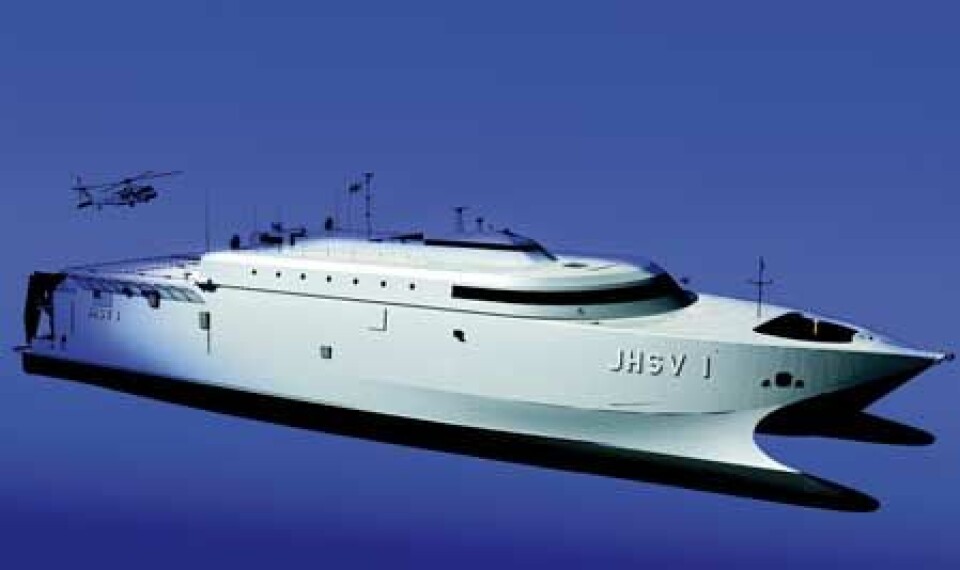
– joint high speed vessel –
An international consortium which includes Incat and Revolution Design has been successful in gaining one of three contracts for the Phase 1 Preliminary Design award made by the United States Department of Defence for the Joint High Speed Vesssel (JHSV) project.
Denne artikkelen er tre år eller eldre.
Incat and Revolution Design are now escalating the design work and collaboration with the consortium of United States shipbuilders towards providing the solution for the US Department of Defense acquisition program for JHSV.
The consortium, comprising Bollinger Shipyards, Incat, Revolution Design, Gladding Hearn and Kvichak Marine, combines the expertise of premier aluminium shipbuilders from the west, east and Gulf coasts of the US with the Australian world leader in high speed craft design and construction.
The JHSV program
is a US Navy led acquisition of a platform intended to support users in the Department of the Navy and Department of the Army, it being a cooperative effort for a high-speed, shallow draught vessel intended for rapid intra-theatre transport of medium sized cargo payloads. The JHSV will reach speeds of 35-45 knots and allow for the rapid transit and deployment of conventional or Special Forces as well as equipment and supplies.
Under the terms of the program the JHSV will offer a high speed transportation capability to support the intra-theater movement of personnel, supplies and equipment for the Armed Services. It will be a US flagged, new construction ship, classed in accordance with American Bureau of Shipping (ABS) Guide for Building and Classing - High Speed Naval Craft (HSNC) standards, certified by the United States Coast Guard (USCG) and designed and built to conform with Safety of Life at Sea (SOLAS) requirements and other commercial and regulatory body rules and regulations as applicable. The ship will receive a Panama Canal/Universal Measurement System (PC/UMS) Net Tonnage Certificate.
Acquisition Process
The US Navy plans to conduct the acquisition of the JHSV as a two-phase procurement. Phase I is a contract for a preliminary design with the award of multiple firm-fixed price contracts with a period of performance not to exceed 180 days.
At the completion of Phase I, the Navy will down select to a single contractor for Phase II, Detail Design and Construction of the lead ship with options for up to seven (7) follow-on ships. The planned date for award of Phase II is 4th Quarter FY 2008. The first Ship delivery is planned for FY 2011.
Proven Technology
Together with Incat and Bollinger, Revolution Design has offered as the SeaFrame base for JHSV, the Revolution 112 metre design which has recently been delivered in civilian guise to HigashiNihon Ferry in Japan, the first of two such vessels for operation between Aomori and Hakodate. This vessel, “Natchan Rera”, the first of a number of 112 metre vessels on order or in negotiation with Incat, has revolutionised Tsugaru Strait crossings for its Japanese operator and has attracted major interest from world wide operators.
This vessel design, having already been built and proven in service, provides the US Navy with a unique opportunity to observe the offered vessel in commercial operation. It is expected that few other designs offered to the Navy will have actually been built and successfully and economically operated. By the time a Phase 2 award is made both of the HigashiNihon vessels will be have been in operation for some time and two other 112m vessels will be in production at Incat. These vessels will have accumulated many thousands of operating hours, which no other design can claim.
Initially, both the Department of the Army and the Department of the Navy pursued separate programs to meet their requirements for intra-theater connectors. However, a decision was made to combine efforts, as collaboration between the Army and Navy would offer increased cost savings for both armed services. The JHSV program combines the Army’s Theater Support Vessel (TSV) program with the Navy and Marine Corps High Speed Connector (HSC).
The JHSV will also be shallow draught, 4.5 metre (under 15 feet) which will further enhance access by enabling the JHSV to operate in shallow waters. This makes the JHSV an extremely flexible asset able to support a wide range of operations including manoeuvre and sustainment, relief operations in small or damaged ports, flexible logistics support, or as the key enabler for rapid transport.










